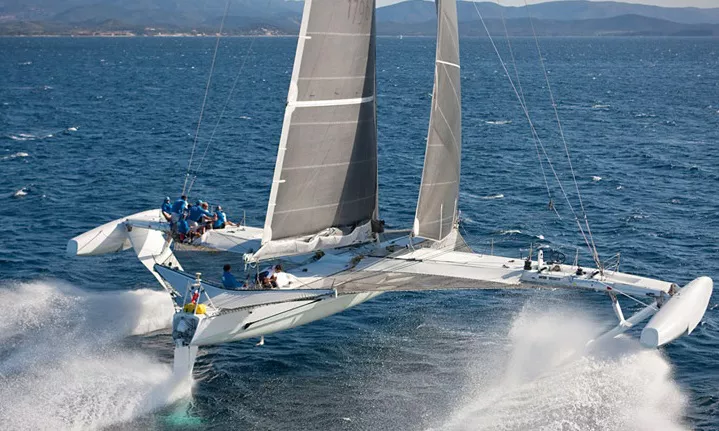Sailing catamarans are celebrated for their speed and stability, making them a popular choice among sailors. These vessels, with their twin-hull design, often outperform monohull boats in terms of speed. But just how fast can a sailing catamaran go? Let’s explore the factors influencing their speed and look at some of the fastest catamarans ever built.
Factors Influencing Catamaran Speed
Several elements determine the speed capabilities of a sailing catamaran:
Hull Design:
The shape and structure of a catamaran‘s hulls significantly impact its speed. Narrow, sleek hulls reduce water resistance, allowing for faster movement. Additionally, the absence of a deep keel, common in monohulls, decreases drag and contributes to higher speeds.
Sail Area and Rigging:
Larger sails capture more wind, providing greater propulsion. The efficiency of the rigging system, which includes masts and sails, also plays a crucial role in transferring wind energy effectively to the boat, enhancing speed.
Weight:
Lighter catamarans experience less resistance in the water, enabling them to reach higher speeds. This is due to reduced drag and improved maneuverability.
Wind Conditions:
The strength and direction of the wind are fundamental in determining a catamaran’s speed. Stronger winds can propel the boat faster, while lighter winds may limit speed.
Speed Ranges Based on Catamaran Types
Catamarans come in various designs, each with different speed potentials:
Cruising Catamarans:
Designed for comfort and stability, cruising catamarans typically reach speeds between 15 to 20 knots (approximately 28 to 37 km/h). These vessels prioritize amenities and are suitable for long-distance voyages.
Sport Catamarans:
Sport catamarans blend performance with comfort, achieving speeds of 30 knots (approximately 56 km/h) or more. They are suitable for sailors seeking both speed and livability.
Racing Catamarans:
Optimized for speed, racing catamarans can surpass 40 knots (approximately 74 km/h). These vessels are built with lightweight materials and advanced designs to maximize performance.
Notable Fast Catamarans
Throughout sailing history, several catamarans have set remarkable speed records:
F50 Catamarans:
Used in the SailGP series, F50 catamarans are among the fastest racing catamarans. In 2024, the Canada SailGP Team achieved a top speed of 55.06 knots (101.98 km/h) during testing in San Francisco.
AC72 Catamarans:
Developed for the 2013 America’s Cup, AC72 catamarans utilized hydrofoils to achieve speeds over 40 knots (74 km/h). Emirates Team New Zealand recorded a peak speed of 47.57 knots (88 km/h) during the competition.
Extreme 40 Catamarans:
These 40-foot carbon-fiber catamarans have a top speed of about 40 knots (74 km/h). They were used in the Extreme Sailing Series, known for their agility and speed.
GC32 Catamarans:
The GC32 is a 32-foot hydrofoiling catamaran with a top speed of about 40 knots (74 km/h). It has replaced the Extreme 40 in the Extreme Sailing Series.
Technological Innovations Enhancing Speed
Advancements in technology have significantly contributed to the increased speeds of modern catamarans:
Hydrofoiling:
This technology involves lifting the hulls above the water’s surface, reducing drag and allowing for higher speeds. Both the F50 and GC32 catamarans utilize hydrofoils to achieve impressive velocities.
Advanced Materials:
The use of lightweight, durable materials like carbon fiber has reduced the weight of catamarans, enhancing speed and performance.
Sail and Foil Design:
Innovative designs in sails and foils have improved aerodynamics and hydrodynamics, contributing to faster speeds. The introduction of T-shaped foils in SailGP’s F50 catamarans is an example of such advancements.
Conclusion
Sailing catamarans are capable of impressive speeds, influenced by factors such as hull design, sail area, weight, and technological innovations. While cruising catamarans offer moderate speeds prioritizing comfort, racing catamarans have achieved remarkable velocities, with some surpassing 100 km/h. Ongoing advancements in design and technology continue to push the boundaries of what these vessels can achieve, making them a fascinating subject for sailors and enthusiasts alike.

